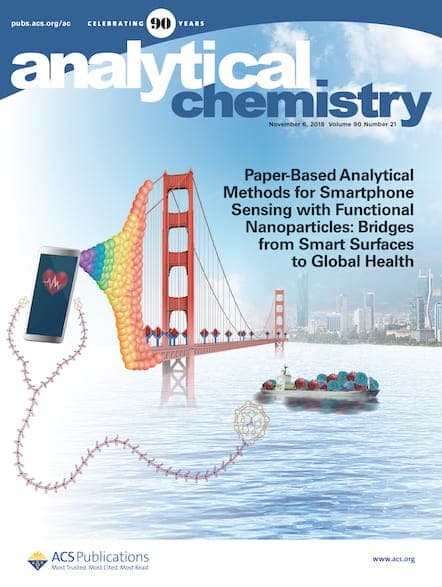Co-sponsored by Analytical Chemistry and The Chemical and Biological Microsystems Society (CBMS), this annual award honors early-career researchers who demonstrate exceptional technical advancement and innovation in the field of microfluidics or nanofluidics.

Co-sponsored by Analytical Chemistry and The Chemical and Biological Microsystems Society (CBMS), this annual award honors early-career researchers who demonstrate exceptional technical advancement and innovation in the field of microfluidics or nanofluidics. The winner receives an award plaque and an honorarium of US $2,500.
Meet the Recipient

Radha Boya, FRSC, is a professor, Royal Society University Research fellow, and Kathleen Ollerenshaw fellow in the department of Physics & Astronomy, and National Graphene Institute at the University of Manchester, United Kingdom.
“I am deeply honored and very happy to receive this award. I believe this is a great time to be working on nanofluidics where many active researchers are in this field. I am extremely proud of my research group members, who are dedicated to solving some of the challenging problems in nano- and angstrom-scale fluidics,” says Dr. Boya.
About Dr. Radha Boya
After completing her Ph.D. in India and a brief post-doctoral stint in the United States, Dr. Boya secured a series of highly prestigious international research fellowships that enabled her to rapidly build her research profile in the United Kingdom (UK). During her Ph.D. at Jawaharlal Nehru Centre for Advanced Scientific Research in India, Dr. Boya first worked on nanofluidics with Prof. G U Kulkarni where she used nanochannels as templates to create nanopatterns of metal-organics and self-assembled metal nanoparticles. In her postdoctoral work with Prof. Chad Mirkin at Northwestern University in the USA, she mostly worked on nanofabrication with dip-pen nanolithography. Following her move to the University of Manchester in the UK working with Sir Andre Konstantin Geim, FRS, HonFRSC, HonFInstP, Dr. Boya has devised nanofabrication methods to make ultimately narrow fluidic channels with angstrom-scale dimensions, by effectively removing a single atomic plane from a bulk layered crystal.
Dr. Boya’s research team investigates the properties of gas, liquids and ions confined in molecular scale with Angstrom (Å) -size capillaries constructed out of 2D-materials. Over the past few years, her work has demonstrated an unprecedented control in making ultra-fine Å-scale capillaries repeatedly. Her research team works on developing Å-capillaries as a platform to experimentally probe intriguing molecular-scale phenomena. As an example, it was shown that water flows through graphene Å-capillaries at an incredibly fast rate ~1 metre/sec while hexagonal boron nitride Å-capillaries (isostructural with graphite) show two orders of magnitude higher water friction. Studying gas flows through the Å-capillaries, they revealed that atomically-flat walls provided by 2D-crystals allow fully-specular reflection of gas molecules, resulting in their ballistic transport and, accordingly, a frictionless gas flow which is enhanced over two orders of magnitude than that expected from theoretical Knudsen description.
With the angstrom-scale and nanofluidic channels that Dr. Boya’s research group works on, interesting fundamental studies can be performed, and insights can be drawn into technological applications can be drawn. Ionic and molecular sieving is of huge importance in applications including desalination, water filtration, dialysis, chemical separation, sensing, and bioanalytics technologies. With the capillaries almost the size of common salt ions (6 to 9 Å), upon flowing salt water through capillaries, Dr. Boya, along with colleagues, showed that the salt ions reconfigured their hydration shell, becoming “squashed.” Without any functional groups on the surface, the nanochannels have to be at least half the size of the ion to sterically exclude the ions. In another collaborative study, they demonstrated voltage-gating of Å-capillaries by a new electro-hydrodynamic effect under coupled hydrostatic pressure and electric force. The Å-fluidic channels are an excellent platform to offer new routes to actively control molecular and ion transport and design elementary building blocks for artificial ionic machinery.
I caught up with Dr. Boya recently to learn more about her research and what’s next for her and her research group. Read highlights from our conversation below.
What advice would you give to upcoming researchers in the field?
Think broadly! Boundaries between the disciplines fade away in nanofluidics research, which has far-reaching applications in various fields like membranes, diagnostics, and smart ionic devices to name a few. Over the last decade, there have been several advances in nanofabrication and characterization tools that make it feasible to study fluidic phenomena at the molecular level. Now is a great time to be working in the field of nanofluidics, which is steadily moving towards angstrom-fluidics, so if you are looking to step into this research field go for it.
How will your work benefit society?
Membrane-based applications with nanoscale channels, such as osmotic power generation, desalination, and molecular separation would benefit from understanding the mechanisms of sieving, ways to decrease fluidic friction, and increasing the overall efficiency of the process. However, mechanisms that allow fast flows are not fully understood yet. Our work on angstrom-capillaries that are only few atoms thick, opens an avenue to investigate fundamental sieving mechanisms behind important applications such as filtration, separation of ions, molecules and gases, desalination, and fuel gas separation from refinery off-gases.
What’s next in your research?
We are working on methods to upscale the fabrication of nano- and angstrom-channels, combining diverse materials and a variety of fabrication methods. We will explore sieving with the nanochannels beyond simple size selection, e.g., what governs the selectivity between same-charge ions with similar hydrated diameters, such as that observed in sodium or calcium ion channels? Another interesting direction using nanochannels we will investigate is to mimic neuromorphic memory using electrolytes in 2D nanochannels. Collaborations with colleagues and across universities are going to be key in these near-future projects.
